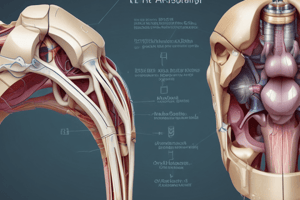Podcast
Questions and Answers
Which of the following nerves is derived from L3, 4, 5, S1, 2?
Which of the following nerves is derived from L3, 4, 5, S1, 2?
- pudendal nerve
- sciatic nerve (correct)
- nerve to obturator internus
- superior gluteal nerve
Which statement about the inferior gluteal artery is incorrect?
Which statement about the inferior gluteal artery is incorrect?
- It is located in the posterior pelvis.
- It is a branch of the internal iliac artery.
- It runs deep to the gluteus medius muscle. (correct)
- It supplies the gluteus maximus muscle.
Which of the following options does not correctly describe the hamstring compartment?
Which of the following options does not correctly describe the hamstring compartment?
- The long head of biceps arises from the lateral facet of the ischial tuberosity.
- The cutaneous nerve supply is from the posterior circumflex femoral nerve.
- The oblique popliteal ligament is an expansion of biceps femoris.
- Semitendinosus lies superficial to semimembranosus. (correct)
Which nerve is not associated with the sciatic nerve?
Which nerve is not associated with the sciatic nerve?
Which nerve is responsible for supplying the tensor fasciae latae?
Which nerve is responsible for supplying the tensor fasciae latae?
Which statement about lymphatic drainage of the lower limb is correct?
Which statement about lymphatic drainage of the lower limb is correct?
Which of the following is NOT a characteristic of fascia lata?
Which of the following is NOT a characteristic of fascia lata?
Which structure is intrasynovial at the knee joint?
Which structure is intrasynovial at the knee joint?
What initiates the 'screw-home' movement during knee extension?
What initiates the 'screw-home' movement during knee extension?
Which muscle is NOT found in the floor of the femoral triangle?
Which muscle is NOT found in the floor of the femoral triangle?
Which statement about the tibialis anterior is correct?
Which statement about the tibialis anterior is correct?
Which statement about the iliotibial tract is correct?
Which statement about the iliotibial tract is correct?
Which statement about the adductor canal is true?
Which statement about the adductor canal is true?
What is the correct statement regarding the great saphenous vein?
What is the correct statement regarding the great saphenous vein?
Concerning the femoral artery, which statement is accurate?
Concerning the femoral artery, which statement is accurate?
What is a true statement about the adductor compartment?
What is a true statement about the adductor compartment?
Flashcards are hidden until you start studying
Study Notes
Nerve Supply and Muscular Functions
- Tensor fasciae latae is mainly supplied by the superior gluteal nerve.
- Anterior cruciate ligament tightens during the 'screw-home' mechanism when extending the knee.
- Tibialis anterior is innervated by the deep peroneal nerve and is not supplied by the tibial nerve.
Knee Joint Anatomy
- Intrasynovial structures in the knee joint do not include the oblique popliteal ligament, the tendon of popliteus, or the menisci; the anterior cruciate ligament is also not intrasynovial.
- The knee joint's 'screw-home' movement involves the anterior cruciate ligament.
Adductor Canal
- Located in the thigh, the adductor canal contains the femoral artery and saphenous nerve.
- The canal does not contain muscular nerves and has adductor longus forming its roof.
Veins and Lymphatics
- The great saphenous vein joins the femoral vein inferior to the inguinal ligament and travels with the saphenous nerve.
- Superficial inguinal nodes consist of about 15 nodes that drain lymph from the lower limb.
Femoral Artery Anatomy
- The profunda femoris artery arises from the anteromedial aspect of the femoral artery and supplies deep structures of the thigh.
- The medial circumflex femoral artery is key in the trochanteric anastomosis along with the superior and inferior gluteal arteries.
Muscles and Bursae
- Gluteus maximus forms the gluteal fold, comprises four bursae beneath it, and primarily receives blood from the inferior gluteal artery.
- In the hamstring compartment, semitendinosus lies superficial to semimembranosus, and the long head of biceps femoris arises from the lateral facet of ischial tuberosity.
Fascia and Tracts
- Fascia lata attaches inferiorly to tibial condyles and head of the fibula, continuous below and reinforced by quadriceps tendon.
- The iliotibial tract lies lateral to tensor fascia latae and attaches superiorly to the iliac crest.
Femoral Triangle Components
- Muscles in the floor of the femoral triangle include iliacus, psoas, and pectineus, while adductor magnus is not present in this region.
Miscellaneous
- The sciatic nerve passes down deep to muscles like quadratus femoris and piriformis; it separates into tibial and common peroneal components near the hip joint.
- The medial intermuscular septum separates the adductor compartment from the posterior compartment of the thigh.
Studying That Suits You
Use AI to generate personalized quizzes and flashcards to suit your learning preferences.




